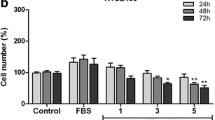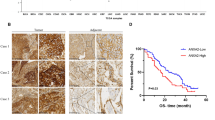Abstract
Background
Expression of activin A is associated with lymph node metastasis and clinical stage in esophageal cancer.
Methods
To clarify the aggressive behavior of tumors with high activin A expression, we used the β subunit of activin A to establish stable activin βA (Act-βA)-transfected carcinoma cells in two human esophageal carcinoma cell lines, KYSE110 and KYSE140. The biological behavior of these cells was compared with that in mock-transfected cells from the same cell lines. We focused our attention on cell growth and tumorigenesis, and proliferation and apoptosis.
Results
Both Act-βA–transfected carcinoma cell lines showed a higher growth rate than the mock-transfected carcinoma cells. In an in vitro invasion assay and a xenograft analysis, the Act-βA–transfected carcinoma cells showed far higher proliferation in vitro and a higher potency for tumorigenesis in vivo, respectively. Moreover, in an analysis of apoptosis via Fas stimulation, the Act-βA–transfected carcinoma cells showed a higher tolerance to apoptosis compared with the mock-transfected carcinoma cells. Moreover, anti–activin-neutralizing antibody–treated squamous cell cancer cell lines inhibited their migration.
Conclusions
Collectively, these data indicate that continuous high expression of activin A in esophageal carcinoma cells is not related to tumor suppression, but rather to tumor progression in vitro and in vivo. The inhibition of activin might be one of the methods to attenuate tumor aggressiveness.






Similar content being viewed by others
References
Asashima M, Ariizumi T, Malacinski GM. In vitro control of organogenesis and body patterning by activin during early amphibian development. Comp Biochem Physiol B Biochem Mol Biol 2000;126:169–78
Yoshinaga K, Mimori M, Yamashita K, et al. Clinical significance of the expression of activin A in esophageal carcinoma. Int J Oncol 2003;22:75–80
Kleeff J, Ishiwata T, Friess H, et al. Concomitant over-expression of activin/inhibin beta subunits and their receptors in human pancreatic cancer. Int J Cancer 1998;77:860–8
Thomas TZ, Wang H, Niclasen P, et al. Expression and localization of activin subunits and follistatins in tissues from men with high grade prostate cancer. J Clin Endocrinol Metab 1997;82:3851–8
Woodruff TK. Role of inhibins and activins in ovarian cancer. Cancer Treat Res 2002;107:293–302
Zheng W, Luo MP, Welt C, et al. Imbalanced expression of inhibin and activin subunits in primary epithelial ovarian cancer. Gynecol Oncol 1998;69:23–31
Wildi S, Kleeff J, Maruyama H, Maurer CA, Buchler MW, Korc M. Overexpression of activin A in stage IV colorectal cancer. Gut 2001;49:409–17
Petraglia F, Florio P, Luisi S, et al. Expression and secretion of inhibin and activin in normal and neoplastic uterine tissues. High levels of serum activin A in women with endometrial and cervical carcinoma. J Clin Endocrinol Metab 1998;83:1194–200
Kojima I, Ogata E. Dual effect of activin A on cell growth in Balb/c 3T3 cells. Biochem Biophys Res Commun 1989;159:1107–13
Rabinovici J, Spencer SJ, Jaffe RB. Recombinant human activin-A promotes proliferation of human luteinized preovulatory granulosa cells in vitro. J Clin Endocrinol Metab 1990;71:1396–8
Di Simone N, Crowley WF Jr, Wang QF, et al. Characterization of inhibin/activin subunit, follistatin, and activin type II receptors in human ovarian cancer cell lines: a potential role in autocrine growth regulation. Endocrinology 1996;137:486–94
Coerver KA, Woodruff TK, Finegold MJ, et al. Activin signaling through activin receptor type II causes the cachexia-like symptoms in inhibin-deficient mice. Mol Endocrinol 1996;10:534–43
Russell CE, Hedger MP, Brauman JN, et al. Activin A regulates growth and acute phase proteins in the human liver cell line, HepG2. Mol Cell Endocrinol 1999;148:129–36
Cocolakis E, Lemay S, Ali S, Lebrun JJ. The p38 MAPK pathway is required for cell growth inhibition of human breast cancer cells in response to activin. J Biol Chem 2001;276:18430–6
Yokomuro S, Tsuji H, Lunz JG III, et al. Growth control of human biliary epithelial cells by interleukin 6, hepatocyte growth factor, transforming growth factor beta1, and activin A: comparison of a cholangiocarcinoma cell line with primary cultures of non-neoplastic biliary epithelial cells. Hepatology 2000;32:26–35
Breit S, Ashman K, Wilting J, et al. The N-myc oncogene in human neuroblastoma cells: down-regulation of an angiogenesis inhibitor identified as activin A. Cancer Res 2000;60:4596–601
Mori M, Mimori K, Sadanaga N, et al. Prognostic impact of tissue inhibitor of matrix metalloproteinase-1 in esophageal carcinoma. Int J Cancer 2000;88:575–8
Yamashita K, Mori M, Shiraishi T, et al. Clinical significance of matrix metalloproteinase-7 expression in esophageal carcinoma. Clin Cancer Res 2000;6:1169–74
Yoshinaga K, Inoue H, Tanaka F, et al. Platelet-derived endothelial cell growth factor mediates Rho-associated coiled-coil domain kinase messenger RNA expression and promotes cell motility. Ann Surg Oncol 2003;10:582–7
Carcamo J, Weis F, Ventura F, et al. Type I receptors specify growth-inhibitory and transcriptional responses to transforming growth factor beta and activin. Mol Cell Biol 1994;14:3810–21
Dennler S, Itoh S, Vivien D, et al. Direct binding of Smad3 and Smad4 to critical TGF beta-inducible elements in the promoter of human plasminogen activator inhibitor-type 1 gene. EMBO J 1998;17:3091–100
Docagne F, Nicole O, Marti HH, et al. Transforming growth factor-beta 1 as a regulator of the serpins/t-PA axis in cerebral ischemia. FASEB J 1999;13:1315–24
Lloyd RV, Erickson LA, Jin L, et al. p27kip1: a multifunctional cyclin-dependent kinase inhibitor with prognostic significance in human cancers. Am J Pathol 1999;154:313–23
Jin L, Qian X, Kulig E, et al. Transforming growth factor-beta, transforming growth factor-beta receptor II, and p27Kip1 expression in nontumorous and neoplastic human pituitaries. Am J Pathol 1997;151:509–19
Qian X, Jin L, Grande JP, et al. Transforming growth factor-beta and p27 expression in pituitary cells. Endocrinology 1996;137:3051–60
Ling N, Ying SY, Ueno N, et al. A homodimer of the beta-subunits of inhibin A stimulates the secretion of pituitary follicle stimulating hormone. Biochem Biophys Res Commun 1986;138:1129–37
Ling N, Ying SY, Ueno N, et al. Pituitary FSH is released by a heterodimer of the beta-subunits from the two forms of inhibin. Nature 1986;321:779–82
Vale W, Rivier C, Hsueh A, et al. Chemical and biological characterization of the inhibin family of protein hormones. Recent Prog Horm Res 1988;44:1–34
Findlay J. An update on the roles of inhibin, activin, and follistatin as local regulators of folliculogenesis. Biol Reprod 1993;48:15–23
Dalkin AC, Gilrain JT, Bradshaw D, et al. Activin inhibition of prostate cancer cell growth: selective actions on androgen-responsive LNCaP cells. Endocrinology 1996;137:5230–5
Liu QY, Niranjan B, Gomes P, et al. Inhibitory effects of activin on the growth and morpholgenesis of primary and transformed mammary epithelial cells. Cancer Res 1996;56:1155–63
Zheng W, Sung CJ, Hanna I, et al. Alpha and beta subunits of inhibin/activin as sex cord-stromal differentiation markers. Int J Gynecol Pathol 1997;16:263–71
Yoshinaga K, Inoue H, Utsunomiya T, et al. N-cadherin is regulated by activin A and associated with tumor aggressiveness in esophageal carcinoma. Clin Cancer Res 2004;10:5702–7
Cavallaro U, Schaffhauser B, Christofori G. Cadherins and the tumour progression: is it all in a switch? Cancer Lett 2002;176:123–8
Suyama K, Shapiro I, Guttman M, et al. signaling pathway leading to metastasis is controlled by N-cadherin and the FGF receptor. Cancer Cell 2002;2:301–14
Acknowledgments
This work was supported in part by the following grants and foundations: a Grant-in-Aid for Scientific Research on Priority Areas of Cancer (14026037, 15023245) from the Ministry of Education, Culture, Sports, Science and Technology of Japan; a Grant-in-Aid for Scientific Research (B) (14370358, 15390398, 15390379, 16390381) and (C) (14570149, 14571140, 15591412, 15591411); and a Grant-in-Aid for Exploratory Research (14657286, 16659337) from the Japan Society for Promotion of Science.
Author information
Authors and Affiliations
Corresponding author
Rights and permissions
About this article
Cite this article
Yoshinaga, K., Yamashita, K., Mimori, K. et al. Activin A Causes Cancer Cell Aggressiveness in Esophageal Squamous Cell Carcinoma Cells. Ann Surg Oncol 15, 96–103 (2008). https://doi.org/10.1245/s10434-007-9631-1
Received:
Revised:
Accepted:
Published:
Issue Date:
DOI: https://doi.org/10.1245/s10434-007-9631-1




